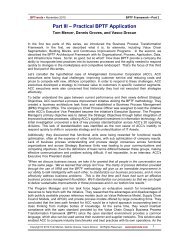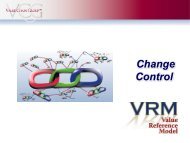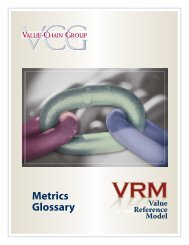Transitioning from - Value Chain Group
Transitioning from - Value Chain Group
Transitioning from - Value Chain Group
You also want an ePaper? Increase the reach of your titles
YUMPU automatically turns print PDFs into web optimized ePapers that Google loves.
T h e O l i v e r W i g h t - W h i t e P a p e r S e r i e s<br />
may be vulnerable to losing the competitive<br />
advantage when what has been industry best<br />
practice becomes industry standard practice.<br />
Only those companies that progress to a fullymature<br />
IBP process continue to be in a position<br />
of sustained competitive advantage in the<br />
marketplace.<br />
What Next<br />
If you believe your company is “stuck” in an<br />
immature S&OP process, the best starting<br />
point is to get an independent assessment or<br />
diagnostic of the current process using the<br />
industry best practice model as a frame of<br />
reference. The diagnostic can be performed<br />
in a matter of days by experienced S&OP/IBP<br />
experts.<br />
A proper diagnostic includes reviewing the<br />
aggregate planning management process<br />
and its connection to the detail planning<br />
and execution processes currently in place. A<br />
series of interviews with the key leadership<br />
and management team members should be<br />
conducted to help the assessor understand<br />
the “Essence of the Business” and to help the<br />
company better understand the more holistic<br />
nature of Integrated Business Planning.<br />
This diagnostic should be immediately<br />
followed up by a facts and findings session<br />
with the leadership and management team.<br />
The purpose of this session is to report the<br />
status of the current S&OP process and to<br />
help inform and educate the company<br />
leadership and management team on<br />
current industry best practices. From<br />
the discussion that occurs during the<br />
interviews and the facts and findings<br />
session, most leadership teams define a<br />
plan to move <strong>from</strong> S&OP to IBP.<br />
relatively immature level, know that companies get<br />
stuck because of:<br />
1) lack of awareness and understanding of what<br />
IBP really is,<br />
2) lack of ambition or motivation for improving the<br />
process, or<br />
3) not knowing HOW to get to the next higher<br />
stage.<br />
The good news: Guidance is available. The Oliver<br />
Wight organization has worked with companies in<br />
every stage and every level of S&OP/IBP for many<br />
decades. We can help by providing a diagnostic and/<br />
or providing full implementation support to ensure<br />
the most rapid time to results for your company.<br />
Summary 6<br />
More and more companies are implementing some<br />
form of integrated business management, often<br />
under the banner of Sales and Operations Planning<br />
(S&OP). Leading companies have evolved S&OP to<br />
a mature IBP process, an integrated, company-wide<br />
management process used as the primary process to<br />
run the business.<br />
This more mature process includes full integration<br />
of the key management processes of the business,<br />
both operationally and financially. Attention is<br />
focused not only on near-term issues, problems,<br />
and opportunities, but also on longer-term more<br />
Done Well, S&OP Evolves Into Class ‘A’ Integrated Business Planning<br />
(IBP)<br />
Figure 8 shows an executive-level<br />
maturity model for S&OP to IBP. Ask key<br />
members of your leadership team where<br />
your company’s management process is<br />
on the maturity chart today.<br />
If you find your company is stuck at a<br />
7<br />
Figure 8 Maturity Model of S&OP to IBP







